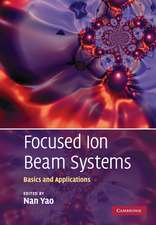Point Defects in Semiconductors and Insulators: Determination of Atomic and Electronic Structure from Paramagnetic Hyperfine Interactions: Springer Series in Materials Science, cartea 51
Autor Johann-Martin Spaeth Hans-Joachim Queisser Autor Harald Overhofen Limba Engleză Hardback – 22 ian 2003
| Toate formatele și edițiile | Preț | Express |
|---|---|---|
| Paperback (1) | 1201.84 lei 43-57 zile | |
| Springer Berlin, Heidelberg – 14 sep 2012 | 1201.84 lei 43-57 zile | |
| Hardback (1) | 1208.05 lei 43-57 zile | |
| Springer Berlin, Heidelberg – 22 ian 2003 | 1208.05 lei 43-57 zile |
Din seria Springer Series in Materials Science
- 18%
 Preț: 1783.25 lei
Preț: 1783.25 lei - 18%
 Preț: 760.38 lei
Preț: 760.38 lei - 24%
 Preț: 689.68 lei
Preț: 689.68 lei - 18%
 Preț: 949.33 lei
Preț: 949.33 lei - 20%
 Preț: 568.94 lei
Preț: 568.94 lei - 18%
 Preț: 934.33 lei
Preț: 934.33 lei - 18%
 Preț: 884.08 lei
Preț: 884.08 lei - 18%
 Preț: 934.33 lei
Preț: 934.33 lei - 20%
 Preț: 948.41 lei
Preț: 948.41 lei - 18%
 Preț: 1119.91 lei
Preț: 1119.91 lei - 18%
 Preț: 1089.00 lei
Preț: 1089.00 lei - 18%
 Preț: 1081.25 lei
Preț: 1081.25 lei - 18%
 Preț: 1201.06 lei
Preț: 1201.06 lei -
 Preț: 464.36 lei
Preț: 464.36 lei - 18%
 Preț: 766.59 lei
Preț: 766.59 lei -
 Preț: 424.76 lei
Preț: 424.76 lei - 18%
 Preț: 1093.76 lei
Preț: 1093.76 lei - 18%
 Preț: 708.39 lei
Preț: 708.39 lei - 15%
 Preț: 628.24 lei
Preț: 628.24 lei - 18%
 Preț: 939.13 lei
Preț: 939.13 lei - 18%
 Preț: 1199.52 lei
Preț: 1199.52 lei - 15%
 Preț: 631.77 lei
Preț: 631.77 lei - 24%
 Preț: 833.43 lei
Preț: 833.43 lei - 24%
 Preț: 1060.33 lei
Preț: 1060.33 lei - 18%
 Preț: 944.55 lei
Preț: 944.55 lei - 18%
 Preț: 1199.52 lei
Preț: 1199.52 lei - 18%
 Preț: 1196.42 lei
Preț: 1196.42 lei - 18%
 Preț: 927.68 lei
Preț: 927.68 lei - 18%
 Preț: 1804.90 lei
Preț: 1804.90 lei - 15%
 Preț: 630.33 lei
Preț: 630.33 lei - 18%
 Preț: 1221.03 lei
Preț: 1221.03 lei - 18%
 Preț: 937.43 lei
Preț: 937.43 lei - 18%
 Preț: 934.19 lei
Preț: 934.19 lei - 15%
 Preț: 624.71 lei
Preț: 624.71 lei - 18%
 Preț: 1210.37 lei
Preț: 1210.37 lei
Preț: 1208.05 lei
Preț vechi: 1473.22 lei
-18% Nou
Puncte Express: 1812
Preț estimativ în valută:
231.20€ • 240.15$ • 192.04£
231.20€ • 240.15$ • 192.04£
Carte tipărită la comandă
Livrare economică 03-17 februarie 25
Preluare comenzi: 021 569.72.76
Specificații
ISBN-13: 9783540426950
ISBN-10: 3540426957
Pagini: 508
Ilustrații: XI, 492 p.
Dimensiuni: 155 x 235 x 33 mm
Greutate: 0.89 kg
Ediția:2003
Editura: Springer Berlin, Heidelberg
Colecția Springer
Seria Springer Series in Materials Science
Locul publicării:Berlin, Heidelberg, Germany
ISBN-10: 3540426957
Pagini: 508
Ilustrații: XI, 492 p.
Dimensiuni: 155 x 235 x 33 mm
Greutate: 0.89 kg
Ediția:2003
Editura: Springer Berlin, Heidelberg
Colecția Springer
Seria Springer Series in Materials Science
Locul publicării:Berlin, Heidelberg, Germany
Public țintă
ResearchCuprins
1. Introduction.- 1.1 Structure of Point Defects.- 1.2 Basic Concepts of Defect Structure Determination by EPR.- 1.3 Superhyperfine and Electronic Structures of Defects in Solids.- 2. Fundamentals of Electron Paramagnetic Resonance.- 2.1 Magnetic Properties of Electrons and Nuclei.- 2.2 Electrons and Nuclei in an External Magnetic Field.- 2.3 Some Useful Relations for Angular Momentum Operators.- 2.4 Time Dependence of Angular Momentum Operators and Macroscopic Magnetization.- 2.5 Basic Magnetic Resonance Experiment.- 2.6 Spin-Lattice Relaxation.- 2.7 Rate Equations for a Two-Level System.- 2.8 Bloch Equations.- 2.9 Conventional Detection of Electron Paramagnetic Resonance and its Sensitivity.- 3. Electron Paramagnetic Resonance Spectra.- 3.1 Spin Hamiltonian.- 3.2 Electron Zeeman Interaction.- 3.3 g-Factor Splitting of EPR Spectra.- 3.4 Fine-Structure Splitting of EPR Spectra.- 3.5 Hyperfine Splitting of EPR Spectra.- 3.6 Superhyperfine Splitting of EPR Spectra.- 3.7 Inhomogeneous Line Widths of EPR Lines.- 4. Optical Detection of Electron Paramagnetic Resonance.- 4.1 Optical Transitions of Defects in Solids.- 4.2 Spectral Form of Optical Transitions of Defects in Solids.- 4.3 EPR Detected with Magnetic Circular Dichroism of Absorption Method.- 4.4 MCDA Excitation Spectra of ODEPR Lines (MCDA “Tagged” by EPR).- 4.5 Spatially Resolved MCDA and ODEPR Spectra.- 4.6 Measurement of Spin-Lattice Relaxation Time T1with MCDA Method.- 4.7 Determination of Spin State with MCDA Method.- 4.8 EPR of Ground and Excited States Detected with Optical Pumping.- 4.9 EPR Optically Detected in Donor-Acceptor Pair Recombination Luminescence.- 4.10 Optically Detected EPR of Triplet States.- 4.11 ODEPR of Trapped Excitons with MCDA Method.- 4.12 Sensitivity of ODEPR Measurements.- 4.13Structural Information from Forbidden Transitions in MCDA-EPR Spectra.- 4.14 Spatial Correlation Between Defects by Cross-Relaxation-Spectroscopy.- 4.15 High-Field ODEPR/ODENDOR.- 5. Electron Nuclear Double Resonance.- 5.1 The Resolution Problem, a Simple Model.- 5.2 Type of Information from EPR and NMR Spectra.- 5.3 Indirect Detection of NMR, Double Resonance.- 5.4 Examples of ENDOR Spectra.- 5.5 Relations Between EPR and ENDOR Spectra, ENDOR-Induced EPR.- 5.6 Electron Nuclear Nuclear Triple Resonance (Double ENDOR).- 5.7 Temperature Dependence and Photo-Excitation of ENDOR Spectra.- 5.8 Stochastic ENDOR.- 6. Analysis of ENDOR Spectra.- 6.1 Qualitative Analysis of ENDOR Spectra.- 6.2 Quantitative Analysis of ENDOR Spectra.- 7. Electrical Detection of Electron Paramagnetic Resonance.- 7.1 Experimental Methods to Detect EDEPR.- 7.2 Experimental Observation of EDEPR.- 7.3 The Donor-Acceptor Pair Recombination Model.- 7.4 On the Role of the Electron Irradiation for the Donor EPR in Silicon.- 7.5 Spatial Resolution and Low Frequency EDEPR.- 7.6 Electrical Detection of ENDOR.- 7.7 Concentration and Temperature Dependence of the EDEPR Signals.- 7.8 Further Spin-Dependent Recombination Models.- 8. Theoretical ab initio Calculations of Hyperfine Interactions.- 8.1 Electron States in Solids.- 8.2 Computational Methods for Deep Point Defects.- 8.3 Hyperfine Interactions.- 8.4 Deep Point Defects in Semiconductors and Insulators.- 8.5 Shallow Defects: The Effective Mass Approximation and Beyond.- 8.6 Conclusions.- 9. Experimental Aspects of Optically Detected EPR and ENDOR.- 9.1 Sensitivity Considerations.- 9.2 ODMR Spectrometers Monitoring Light Emission.- 9.3 ODMR Spectrometers Monitoring Magnetic Circular Properties of Absorption and Emission.- 9.4 Experimental Details of the Components of an MCDA/MCPE ODMR Spectrometer.- 9.5 High Frequency ODEPR/ODENDOR Cavities.- 9.6 High Pressure Photoluminescence-Detected EPR.- Appendices.- References.
Textul de pe ultima copertă
This book introduces the principles and techniques of modern electron paramagnetic resonance (EPR) spectroscopy that are essential for applications used to determine microscopic defect structures. Many different magnetic resonance methods are required for investigating the microscopic and electronic properties of solids and uncovering correlations between those properties. In addition to EPR such methods include electron nuclear double resonance (ENDOR), electronically and optically detected EPR (the latter is known as ODENDOR), and electronically and optically detected ENDOR. This book comprehensively discusses experimental, technological, and theoretical aspects of these techniques from a practical point of view with many illustrative examples taken from semiconductors and insulators. The non-specialist is informed about the potential of the different methods. A researcher finds practical help in the application of commercial apparatus as well as useful guidance from ab initio theory for the task of deriving structure models from experimental data.
Caracteristici
Includes supplementary material: sn.pub/extras





